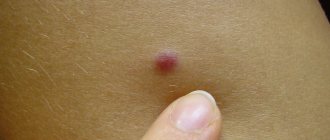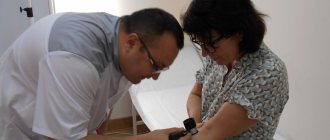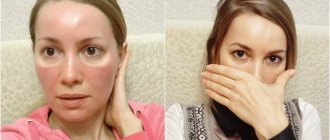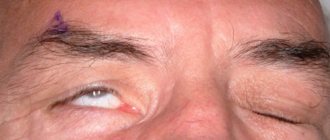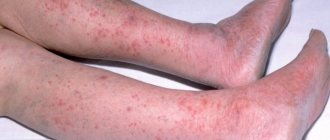Red moles (angiomas) are vascular neoplasms, the diameter of which ranges from several millimeters to several centimeters. Most often, angiomas appear during fetal development (congenital angiomas), but they can also occur after birth.
Small red moles can be localized on the stomach, arms, legs, back, chest, face, neck, and also on internal organs. Depending on the shape, there are three types of red moles: dotted, cavernous and stellate.
Why do red moles appear on the body?
Red moles are formed by a large number of microscopic blood vessels (hemangiomas) and lymphatic vessels (lymphangiomas). The main reason for the appearance of red moles is dysfunction of the circulatory and lymphatic systems. Angiomas are divided according to type:
| Types of angiomas | |
| Types of angiomas depending on the morphological structure | hemangiomas that develop from blood vessels |
| lymphangiomas, which form from lymphatic vessels | |
| Types of angiomas depending on the cellular structure | monomorphic, consisting of the same type of cells |
| polymorphic, which combine several cell types | |
| Types of angiomas depending on type | simple (capillary) angioma - occurs due to the proliferation of capillaries |
| branched angioma - a branched network of dilated capillaries | |
| cavernous angioma - wide spongy cavities filled with blood | |
| combined angioma, combining cavernous and simple types | |
| Types of angiomas depending on location | spine - predominant location in the thoracic and cervical regions, affecting one or more vertebrae |
| skin - red moles on the body | |
| brain - vascular angiomas in the brain substance | |
| liver - single or multiple vascular neoplasms located in different parts of the organ | |
| kidneys - angiomas are formed from the veins and arteries that supply the organ | |
The most common causes of angiomas on the body are:
- hormonal changes in women (during pregnancy, taking oral contraceptives);
- skin injuries;
- genetic characteristics of the organism;
- diseases of the gastrointestinal tract, liver and pancreas;
- long exposure to sunlight and frequent visits to the solarium.
What does the appearance of red moles on the body mean?
If red moles appear on the body, this may be a simple cosmetic defect, or it may indicate pathological processes occurring in the body. In some cases, the occurrence of angiomas indicates poor nutrition, prolonged exposure to the sun, and a sludge buildup in the body.
Red dots like moles may indicate increased estrogen levels in the body, liver dysfunction and increased insulin in the blood. In addition, in some cases, angiomas appear as a response of the body to a lack of iodine, magnesium, chromium, vitamins C and K.
How to get rid of spider veins
The most commonly used technique for eliminating them all over the world is sclerotherapy - that is, the injection of a special drug into a vein using a very thin needle, which leads to their disappearance. Sometimes this procedure can not only improve appearance, but also eliminate some symptoms of chronic venous diseases: itching, burning, heaviness in the legs, night cramps.
In addition to sclerotherapy, percutaneous laser and thermocoagulation are also used to treat spider veins, but the frequency of their use does not exceed 5% of cases. We especially want to emphasize that it is impossible to remove spider veins with any tablets, ointments or creams, so you should not trust this kind of advertising! Before removing spider veins, you will first undergo an ultrasound examination of large veins to exclude their pathology. If changes are detected in these vessels, it is advisable to treat them at the first stage in order to achieve the best result. However, this situation occurs rarely, because damage to large veins is usually visible to the naked eye. In the corresponding section you can also learn more about the treatment options for varicose veins. We hope you find our site informative.
Rice. 3 Result of sclerotherapy
Important! No cream, ointment or drug can remove spider veins.
In the corresponding section you can also learn more about the treatment options for varicose veins.
Sign up for a consultation with us to learn more about spider veins and their treatment methods that are suitable specifically for your case.
What to do if red moles appear on the body?
If red moles appear on the body in large numbers, single angiomas increase in size, or trauma to the red mole occurs, you should consult a dermatologist. Diagnosis of angiomas that are located on the surface of the skin is usually done by visual examination and palpation.
If there is a suspicion of the presence of red moles in the internal organs, additional research will be required to detect them. Skeletal angiomas are determined using x-rays of the spine, ribs, pelvis, bones and skull. Angiography (contrast X-ray examination of blood vessels) allows identifying red moles in the lungs, kidneys, brain and other internal organs. The structure of the angioma and the features of its location are determined by ultrasound examination.
After the diagnosis, the dermatologist will determine whether it is necessary to treat the red mole. So, the absolute indication for removing red moles is their rapid growth.
In addition, indications for treatment of angiomas are:
- localization in the neck and head;
- disruption of the functioning of the internal organ in which the angioma is located;
- extensive tissue damage around the red mole.
Treatment of red moles involves their removal, which can be done in various ways. Treatment methods for angiomas include:
- laser therapy;
- radio wave method;
- cryotherapy (removal of angiomas using liquid nitrogen);
- diathermoelectrocoagulation (cauterization with electric current);
- hormone therapy;
- ligation of the arteries that feed the angioma;
- surgery.
Effective therapy for red moles can only be prescribed by a dermatologist. Treatment of angioma with folk remedies is not recommended.
What to do with local redness
Treatment of vascular pathologies and infectious diseases should be carried out under the supervision of a specialist on an outpatient basis. If the doctor determines that there are no medical problems, you can try to eliminate the defect yourself. Beauty salons offer several options for treating redness on the skin. Among the most effective:
- cryodestruction;
- ozone therapy;
- electrocoagulation;
- laser exposure;
- diathermocoagulation.
At home, whitening masks, lotions and compresses are effective.
The choice of method depends on the cause of the stains. Electrocoagulation and diathermocoagulation will help remove the effects of rosacea. The affected areas of the vessels are removed with an electrical impulse or a hair electrode. Cryodestruction allows you to quickly and painlessly get rid of angiomas. Sclerosing therapy can also help remove vascular tumors. Adhesive substances are injected into damaged vessels to promote the growth of collagen fibers. Red acne is treated with mechanical or chemical peels, as well as laser resurfacing.
Mechanical resurfacing will help deal with red spots on the skin.
Are red moles dangerous?
Unlike melanoma (a malignant tumor), angioma is a benign formation. Single red moles on the body that do not increase in size and do not cause discomfort do not require treatment and are not dangerous.
But in some cases, red moles can lead to complications. Internal angiomas, depending on their location, can cause shortness of breath, difficulty breathing, epilepsy, impaired vision and hearing. In addition, angiomas can lead to complications if:
- red mole growing;
- there is a possibility of injury;
- many red moles appeared on the body;
- there is a risk of the mole transforming into a malignant formation.
Preventive measures
A mandatory point of treatment is a balanced diet. It is especially important for people suffering from allergies or congenital vascular weakness. Fatty and sweet dishes, hot seasonings, canned food, smoked meats and sausages are removed from the menu. It is necessary to completely eliminate alcohol and smoking; nicotine, tobacco tar and ethyl alcohol destroy the weak walls of blood vessels. The diet includes fresh vegetables and fruits, dairy products, animal proteins (fish, poultry). These products strengthen capillaries and stimulate the production of natural collagen.
It is important to protect your face from aggressive sun rays. Before going outside, apply a cream, gel or spray with a high SPF to your face. Properly selected decorative cosmetics can also hide redness. A foundation without mineral oils covers imperfections well and does not cause irritation. It is important to avoid contrasting procedures: steam baths, ice compresses. They have a destructive effect on fragile capillaries and increase the risk of their rupture.
Preventing the appearance of red moles
It is impossible to prevent the occurrence of congenital angiomas. A congenital red mole in a child is most often a short-term formation and disappears by the age of 5-7 years. Therefore, if the child does not complain of pain or itching in the area of the angioma, there is no need to worry.
In order to avoid the occurrence of angiomas after birth, it is necessary to follow these recommendations:
- avoid prolonged exposure to direct sunlight and frequent visits to the solarium;
- follow a sleep and nutrition schedule;
- lead a healthy lifestyle.
If you have a red mole, it is important to monitor its development and contact a dermatologist at the first signs of injury or change in size. With timely consultation with a doctor, it is possible to prevent complications of angiomas and, if necessary, begin therapy on time.
7
2
8
Article rating:
4 out of 5 based on 50 ratings
Author: Christopher Vasily Alekseevich
Dermatologist, pediatric dermatologist. Highest category. Work experience 24 years.
Allergies on the face and neck
If it is confirmed that it was allergies on the face and neck that caused the redness and rashes, the allergen will be identified. More often such rashes are provoked by:
- Food;
- Seasonal flowering of plants, pollen;
- Cosmetics for face and neck care;
- Contaminated air;
- Medicines, etc.
Allergy on the chin
If, after diagnosis, the doctor determines that your redness is an allergy on the chin, and not another type of disease, then the allergen will be identified and appropriate therapy will be prescribed. But often a small red rash on the chin indicates hormonal changes in the body. Therefore, such rashes occur:
- In adolescents - during the formation of the hormonal system;
- In adults after 45 years, when restructuring of the body also begins and hormonal levels change.
Then it will be enough to take a blood test for hormones, and the doctor will determine the true cause of the spots on the face.
Allergic acne on forehead
When red spots appear on the forehead, doctors can diagnose:
- Diseases of the small intestine - in the central part of the forehead;
- Adrenal glands - near the eyebrows;
- Rectum - on the left side of the forehead;
- Large intestine - at the top, near the hair;
- Bladder - at the temples;
- Endocrine and hormonal systems - small rash in any area of the forehead;
- The nervous system is a large red spot.
If allergic acne on the forehead is determined after examination, then the treatment regimen is the same:
- Identification of the main allergen;
- Its elimination;
- Prescription of the treatment complex.
You don’t have to wonder why you have a rash on your face, you just need to come to the Allergomed clinic, where they will definitely help you get rid of them.

